Believe it or not, it’s not always easy coming up with a topic every week. And even when I do come up with one, there’s no guarantee I can pull it together in the time allowed. That’s been made even more awkward right now, since my bank screwed up and didn’t send me my new check card, thereby seriously limiting the amount of damage I can do by way of “research” (read: spending binges) on Amazon at 3 a.m. (More often than not, I end up spending more on these columns than I get paid for them. Enthusiasm or brain-damage? You decide.)
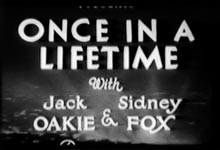
All this palaver is merely a way of leading into something I’ve decided to do by way of the occasional stop-gap column—namely to take a look at some movies of note that it’s highly probable most folks have never seen. Calling them great is likely somewhat on the hyperbolic side, but who’s going to read something called “Pretty Decent Movies You’ve (Probably) Never Seen?” There are some gems lying around waiting to be discovered, yes, but whether they’re diamonds or zircons is another matter.
The downside to this concept lies in the fact that in many cases, all you’re likely going to be able to do is read about them, which is to say there’s a lot of stuff out there that’s yet to make it to DVD—or even fall under the gaze of the programmers at Turner Classic Movies. In the latter case, however, I’m told—on very good authority—that the TCM programmers actually do pay attention to viewer requests, so if something catches your eye in these occasional columns, they’re the folks to badger about showing it.
The film up for consideration this time is Russell Mack’s film version of the Moss Hart-George S. Kaufman play Once in a Lifetime (1932). If you’re not familiar with the play, you ought to be. Its large cast makes it rarely revived, but it makes a good read. The old Modern Library Six Plays by Kaufman and Hart, which includes the title, isn’t hard to find. The film, on the other hand, is.
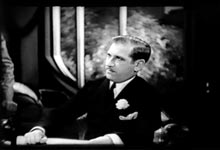
Long considered a lost film, Once in a Lifetime resurfaced in the late 1960s and found its way to a showing on NET (before it became PBS) in 1970 or 1971. For some reason, the 91 minute film was trimmed to 80 minutes for this transmission. This version lost none of the plot, but did hurt the characterizations and lose some of the film’s atmosphere. (I’m not sure why it was cut, except to make room for a short documentary on lost movies in the 90 minute space.) Still, it got the film out there—and it’s this transmission from nearly 40 years ago is how most people know the film, because it went straight back into obscurity.
I was fortunate enough to have access to a good cross-section of private collectors and a most excellent expert at transferring 16mm prints to video. One day I happened to ask him about Once in a Lifetime. About two weeks later, it was in my hands in a perfectly fine copy. I was greatly surprised to find the film considerably longer than the NET version, which I’d always assumed was complete. (No, my memory’s not that good, but back in the old days a lot of us would record the soundtracks of movies from television. While I hadn’t seen the film is at least 15 years, I’d heard it lots of times. We were, I suppose, easily amused then.) I was also pleased to see how well the movie held up.

So what exactly is this all-but-forgotten classic? Simply put, it’s everything Singin’ in the Rain (1952) only thinks it is in terms of Hollywood satire, and then some. The story follows the fates of three washed-up vaudevillians—Jerry Hyland (Russell Hopton), George Lewis (Jack Oakie), May Daniels (Aline MacMahon)—who reinvent themselves as elocution specialists and beat a path to Hollywood to take advantage of the panic brought on by the talkies (“None of these bozos have ever talked on the stage. They’ve never spoken lines before”). Securing the good will (and opportunistic tendencies) of Hollywood gossip columnist Helen Hobart (Louise Fazenda) they get their chance. (Despite the similarity in name to Hedda Hopper, Hobart is a thinly veiled version of Louella Parsons. Hopper wouldn’t pursue her gossip columnist career for several years.)
Historically, the play—and the film even more so—is dead on the money about the panic and the influx of elocution teachers. It’s also completely on target as concerns the Hollywood mindset. In fact, it’s so on target that it remains relevant to the Hollywood of today with its emphasis on thrusting big name stars into parts they aren’t suited for, and the mania for trying to duplicate successes by making more films of the same kind until the trend is played out—and even beyond. Substitute terms like “mindless action movies” and “comic book movies” for the references to “backstage musicals” and “aeroplane pictures” and you have the identical modern modus operandi in different clothing.
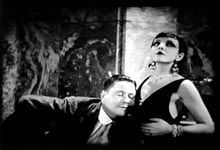
The film—adapted by Seton I. Miller (fresh from working on dialogue and continuity for Howard Hawks’ Scarface the same year)—is reasonably faithful to the play. Apart from opening the play up at the beginning (allowing us to see our three heroes in an act that could easily have killed vaudeville by itself), Miller mostly dropped some tangents and toned down the more censorable aspects of the play. A very funny dialogue between cigarette girls in a nightclub—discussing playing talkie prostitutes as opposed to silent ones—fell victim to the changes, but the bulk of the changes consist of dropping the “goddams” and making “God-awful” into “awful.” Since 1932 was prior to the Production Code, a lot of the cruder jokes passed through unchanged.
Perhaps the biggest surprise is that the film should have been made by Universal. There’s no room for doubt that Herman Glogauer (played with English-mangling delight by Gregory Ratoff) is primarily fashioned after Universal founder and president Carl Laemmle. Good Lord, even the Glogauer Studios’ prestige pictures are called “Super Jewels,” the name “Uncle Carl” slapped on his occasional bids for respectability with more artistic movies.
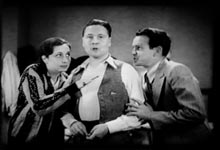
The studio itself—inhabited almost exclusively by German immigrants on the production end—also recalls the nepotistic Laemmle, who got the name “Uncle Carl” because so much of Universal’s workforce was made up of relatives from the old country. For that matter, the film’s settings—likely by an uncredited Charles D. Hall—make a subtle joke of Laemmle’s Jewishness via art deco chromium strips around the doors, which look suspiciously like one side of a menorah. Of course, a lot of this was applicable to Hollywood in general, but the direct jabs at Laemmle are hard to miss.
Nonetheless, Uncle Carl not only made the film, he (or more likely a studio publicist) justified his position by starting the movie with a creeper title reading, “When I bought the moving picture rights to Once in a Lifetime, the stage play which so mercilessly and so hilariously poked fun at Hollywood and its motion picture people, the critics said I would not dare make use of its best material on the screen. It was too funny, they said, and would make the world laugh at us! I pity the man who cannot enjoy a laugh at his own expense. So I decided that if I could make the world laugh in times like these, it would be a great thing to do. I now leave it for you to judge whether I have spared the movies in translating the great stage success to the screen.” Imagine that being spoken with a thick accent and it really sets the tone.
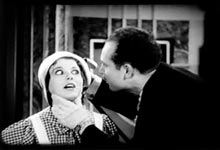
When the talkies arrived, movie studios were in a frenzy concerning whether or not their silent stars could make it in this new medium. Some heavily-accented luminaries—notably Greta Garbo—were kept from making talkies as long as possible. But there was more at stake. Studios were worried that their writers weren’t up to the task of writing actual dialogue and so playwrights and even novelists were brought in for this purpose. Could silent movie directors deal with coaching actors to deliver lines? This last concern—not addressed in Once in a Lifetime—resulted in the film directing careers of James Whale, George Cukor and Rouben Mamoulian, all imported from the stage.
For the elocution aspect of the satire, the film offers us Phyllis Fontaine (Mona Maris) and Florabel Leigh (Carol Tevis). “They are beautiful girls, but unspeakable,” Glogauer informs the bogus voice teachers, and that’s a pretty fair statement, since Fontaine has a largely impenetrable accent and Leigh (the obvious model for Jean Hagen in Singin’ in the Rain) boasts a painful Brooklynese screech. It’s a hopeless case, but May Daniels is undaunted. “May I ask if you ladies have ever breathed rhythmically?” she inquires, claiming that “rhythmic breathing is the basis for all tonal quality.” Assuring Glogauer that these ladies can be taught to speak correctly (“For the present they should just keep breathing”), May lands herself and her companions jobs at the studios.
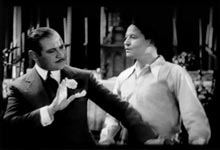
It hardly matters that none of the three know very much about elocution, since Glogauer knows even less. (When assured that the stars will be soon be speaking as well as he does, Glogauer blissfully replies, “Well, I don’t ask for miracles.”) All in all, it’s a large scale case of fakes cashing in on people who are just as phony as themselves and fancy themselves too smart to be snookered. The whole elocution business quckly degenerates into the trio’s dim-bulb, George (dubbed “Dr. George Lewis” in a fit of inspiration by May), making chorus girls recite Rudyard Kipling’s poem “Boots” in imitation of the even-dumber Hollywood wanna-be Susan Walker (Sidney Fox) he’s besotted with.
While all this is going on, we meet playwright Lawrence Vail (Onslow Stevens), a hapless soul who spends his days sitting in the ante-room waiting to see Glogauer. The role was originally played on Broadway by George S. Kaufman himself, who drew on his own dealings with Hollywood for the character. Vail finds himself a highly paid writer with nothing to write. “I have an office with my name in gold letters on the door,” he notes at one point, but adds that he’s never met Glogauer, never received an assignment and, in fact, never even seen anyone but the girl who brings him his paycheck. He also cleverly serves as the catalyst for the second half of the story.
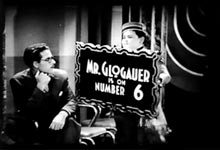
Not surprisingly, the elocution school is a flop. (“Oh, Miss Daniels, we’re still breathing in here,” calls Miss Leigh from a window at one point, only to be assured by May, “Yeah? Well, I’ll soon put a stop to that.”) But just as all three are headed for the axe and a quick trip back east. “Dr.” Lewis runs into Vail, who has finally had enough and has just tendered his resignation to the affected receptionist, Miss Leighton (ZaSu Pitts), in no uncertain terms. “Tell me something. They make talking pictures here,is that right? This is a picture studio? They make pictures here—pictures that talk? They do something here, don’t they? Now, now, now, don’t be afraid of me, little girl, I’ll not harm you. It’s just that I’ve been in that office—the one with my name on the door—for months and months, and nobody ever noticed me alone in there, and the strain of it got to be too much and so I came out! Now, I don’t want to see Mr. Glogauer anymore. I just want to go in and wander around, because tomorrow I’m going home and I want to be able to tell them there that I saw them made. And who knows? Maybe I’ll run into Mr. Glogauer—I’d love to know what Napoleon looks like before I die!”
Running into “Dr.” Lewis, he tells the easily befuddled George (“Don’t you like it here?”) his whole rant on how “Hollywood and this darling industry of yours is the most awful thing I’ve ever run into.” To say that George isn’t a deep thinker is an understatement, but he is very good at parroting what other people say to him (albeit in a sometimes mangled form). So when he finds that not only has he been fired, but Glogauer won’t give the talentless Susan a chance, he lets loose on the studio head with Vail’s tirade—and even slightly embellishes it by doing the one thing no one dares to do, reminding Glogauer, “You turned the Vitaphone down.” (Vitaphone was the name of the system that made talkies possible.) Of course, all this boldness so impresses Glogauer that he puts “Doctor” in the position of heading up the studio—giving him carte blanche to rehire his friends and make Susan a star.
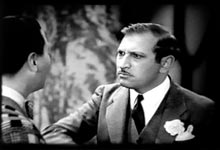
This position of power proves to be just as tenuous as everything else about Hollywood, as is illustrated when George accidentally films a 1910 script rather than the backstage musical he was supposed to produce. “After this, I make a ruling,” announces Glogauer when he finds out, “I make a ruling—every story we ever produce somebody’s got to read it!” Virtually everyone involved gets fired, naturally, and Glogauer even repossesses his gift to George of “a solid gold dinner set—106 pieces and with his initials in diamonds on each piece.”
May heads back east, but meets Vail (fresh out of a stay in a sanitarium) on the way, telling him the story. “Funny, I should’ve thought there’d be a great field out there for a man who could turn out the wrong picture,” reasons Vail. “Yes,” agrees May, “if he could do it regularly, but sooner or later, Dr. Lewis would make the right one and spoil everything.” But then the newspapers with the reviews arrive and, lo and behold, the critics have gone lollipops over this mess of a mistake.
They rave over it being a break from the avalanche of backstage musicals. They applaud such technical deficiences as the lighting (“Most of it you can’t see because the Doctor forgot to tell them to turn the lights on,” May has explained), which the critics decide is a deliberate artistic choice to “leave the climax to the imagination of the audience.” George’s tendency to constantly eat Indian nuts (“He kept cracking them right through the picture and they recorded swell”) is transformed in their minds into a stroke of genius—“What was being done was what Eugene O’Neill did with the constant beating of the tom-tom in The Emperor Jones; it was the beating of the hail on the roof.” Even Susan’s (aptly described by May as having a chance at being the world’s worst actress) performance is praised, and George is “the new genius of the film.” (Woody Allen must’ve remembered this when he made Hollywood Ending in 2002.)
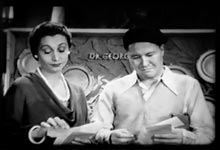
That’s not all, of course. “Dr.” Lewis being “Dr.” Lewis has once more fallen from grace (he buys 2,000 airplanes for the studio, because he got one for free), but even that has a twist, since it turns out that all the studios want to make aviation movies and they can’t because George bought up all the planes. And so it goes—with a final gag invented specifically for the film.
Rare for a Universal picture from 1932, the studio gave the whole film solid production values, but more they had the sense to import stars from other studios for the picture. They borrowed Jack Oakie from Paramount, and secured the glorious Aline MacMahon (quite possibly the coolest actress who ever lived) from Warner Bros. ZaSu Pitts was brought in from her popular series of Hal Roach comedies—and, strangely, given a role that allowed her to play something other than her usual ditsy self, though the film does use her signature hand-flailing. (If you don’t know Pitts, you likely know her cartoon incarnation. She was the model for Olive Oyl in the Max Fleischer Popeye shorts.) The wonderful Gregory Ratoff took time out from RKO to play Herman Glogauer (“What did they have to go and make pictures talk for? Things were going along fine. You couldn’t stop making money. Even if you turned out a good picture, you made money”) and was worth at least three times whatever they paid him.
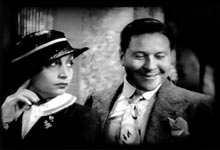
Universal contract player the tragic Russell Hopton (he committed suicide in 1945) got his biggest shot at stardom with this movie, but he never caught on. Neither did Laemmle protege Sidney Fox (another suicide), whom the studio tried to build up for a few years. Susan Walker was one of the few roles she was ideally suited for. Similarly, Onslow Stevens was a contractee who never quite made it (apparently due to alcoholism), but ended his days bizarrely by being murdered in a nursing home in 1977.
The one corner-cutting aspect of the film may be its biggest downside—the handling of the film by hack director Russell Mack. At his best, Mack is competent, but he’s never exactly inspired. Fortunately, comedy doesn’t rely as much on cinematic technique as most genres. The fact that the gags “register” with the viewer is all that really matters, and the gags generally do at least that here. A little more verve might have helped, but all in all Mack does a credible enough job.
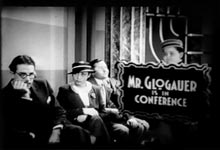
Much of what is best about Once in a Lifetime is found in its little touches—knowing jabs at Hollywood. There are bits of casual absurdity scattered through the film—like realizing we’re in a world where people saying things like, “Mr. Glogauer will look at Foolish Virgins at 2:15,” are said with a straight face. It’s a realm in which references are made to patently ridiculous movies such as The Seven Commandments (the budget—or the censors—must not have allowed for the full ten), and where the crotchety character actor (Frank LaRue) playing the priest in “Dr.” Lewis’ production, hears that title and volunteers, “I played a rabbi in that one.”
Unfortunately, Once in a Lifetime—which may just be the ultimate Hollywood satire—is all but unknown today. But that doesn’t have to be. As I noted, Turner Classic Movies does take requests for movies seriously and—assuming that the film hasn’t become embroiled in a rights dispute with the playwrights’ estates—they do not limit themselves to the films that Turner owns (Universal should still have the rights to this). Requests that they show the film and get it back into the public eye isn’t the worst way you could spend your online time.



A request to the TCM programmers is certainly in order. I haven’t seen it in a couple decades (and couldn’t begin to tell you if I saw a cut version or not), but I have very fond memories of it.
My guess would be that if you saw it on PBS, it was the 80 minute version, but that’s only a guess, since I never heard of it being shown after that original airing in 1970-71. Of course, PBS showings are pretty much a hit and miss thing and almost wholly dependent on the programmers at the individual stations. The few comments the film has garnered on the IMDb tend to refer to the era I saw it in, but one of them pegs it at 1969, which I know is earlier than when it made it to my station in Florida (I was either a sophomore or junior in high school).
It’s interesting that when it was shown the documentary on lost movies that preceded it had such titles as The Front Page (1931) and The Emperor Jones (1933) among the missing, both of which are readily available today. Films that we were told we’d probably never see — like those and The Smiling Lieutenant (1931), The Old Dark House (1932), Mystery of the Wax Museum (1933) and Charlie Chan in Paris (1935) — were returned to us. This is the only case I can think of where a “lost” film was found, only to seemingly disappear again.
Seems to me that 70-71 might be a bit too early, if only because I’m not sure I was yet aware enough of George S. Kaufman and his works to want to check out the film. I also don’t recall a documentary attached to the showing. It seems to me I saw it in a standard Late Movie setting in the late 70s or early 80s.
I would have thought by ’71 at the latest you’d have been pretty Kaufman aware, if only because of the Marx Bros. connection.
I don’t know that you could properly call the thing that ran before the film on that original showing a documentary. It was — as I recall — mostly still and someone talking about the missing films for probably 10 min. tops.
Actually I believe I came to an interest (or an increased interest) in the Marx Brothers through an existing interest in Kaufman. I never had an opportunity to see a Marx film until college, but I saw either a school or community theater production of YOU CAN’T TAKE IT WITH YOU by the time I’d reached high school.
The TV channels we could receive back in the 1960s had crappy movie selections; in fact they played damn few movies at all. I do recall at some point in my mid-teens turning on the TV to discover the Marxes running amuck on a ship. “Christ! I hate them!” announced my father who promptly switched the channel in search of a golf match.
Of course trying to untangle precise time-lines after 30+ years ain’t easy, but I believe I stumbled across a bio of Kaufman just after the end of my senior year in high school.
Anyway, yes I should have been aware of Kaufman by 1971… I just can’t place my having seen ONCE IN A LIFETIME as early as 1971. It seems it must have taken place 5 – 10 years later. I certainly seem to recall watching it as a Late Movie, which means I was either in my own apartment or it was after I’d moved back home to care for my parents (they’d gotten cable by then).
Of course trying to untangle precise time-lines after 30+ years ain’t easy, but I believe I stumbled across a bio of Kaufman just after the end of my senior year in high school.
That would probably be the Howard Teichmann book and the date would be about right because I got that during my junior year in high school.
And I remembered another reason that argues against my having seen it in 1971-ish. In fall of 1970 I went to college and between the apartments I had then & in several I had afterward, I had no television (much less cable) until about 1979.
Now I might have chanced across it while on a visit home, but…
Now once I got a TV in my apartment in ’78 or ’79, I had access by cable to 3 Philadelphia network affiliates & 3 independents, all of which showed really obscure stuff in the wee hours.
And yes, it was almost certainly the Teichman book.
I despair over the continued revelations of your deprived (and possibly depraved) youth without recourse to cinema via the TV screen for such extended periods of time.
The periods I spent TV-less, I was so occupied doing theater that I didn’t miss having one, for the most part. The lack of a TV in college was also offset by the fact that the college had a very good film program which introduced me to W. C. Fields (INTERNATIONAL HOUSE), the Marxes (NIGHT AT THE OPERA and DUCK SOUP) and others. There were two or three movie nights a week in one venue or another on campus. Hell, the TV stations I had access to prior to college were so pitiful in movie showing that being TV-less at college was heaven by comparison.
BTW… Depravity came well after youth, I fear.